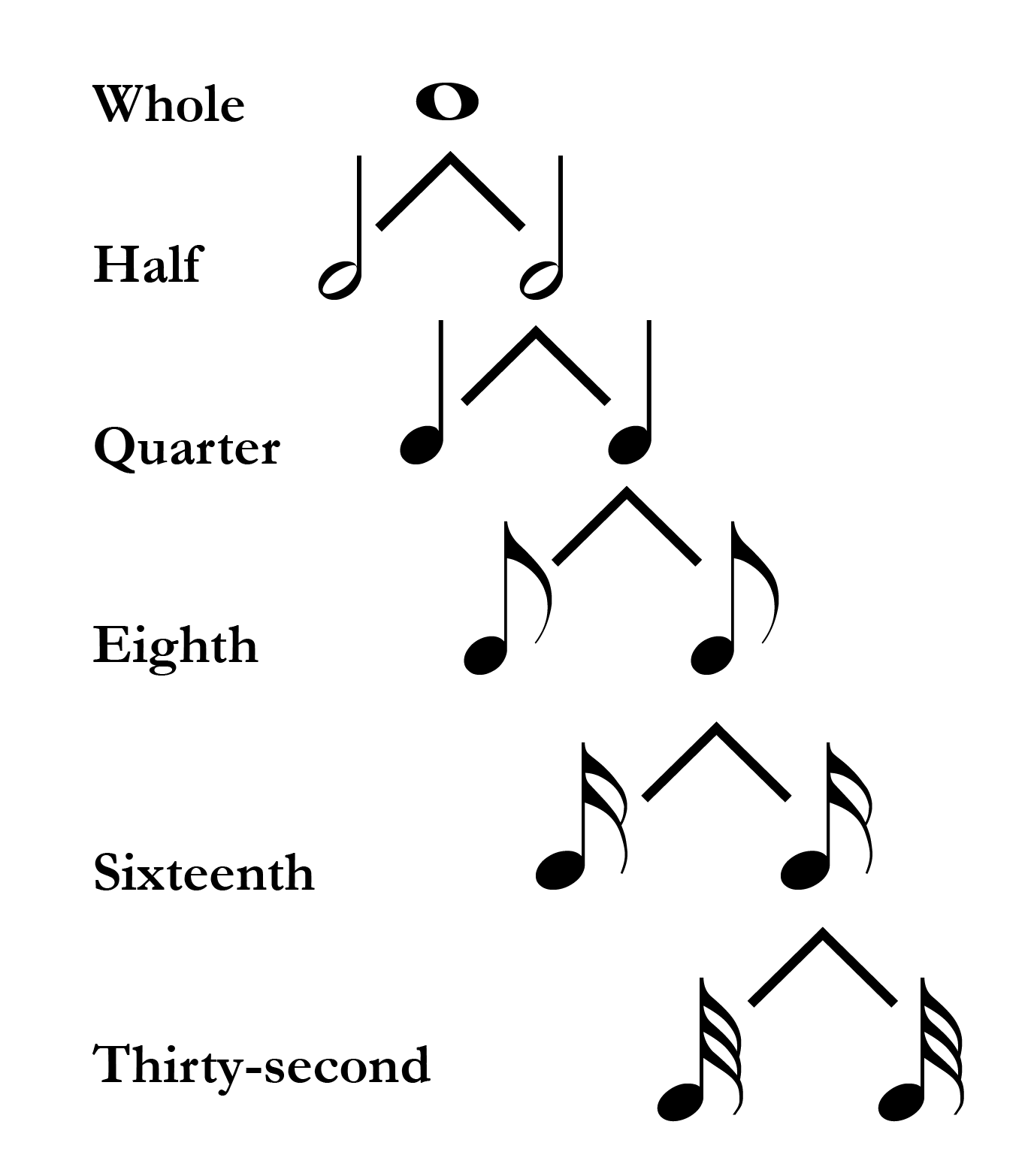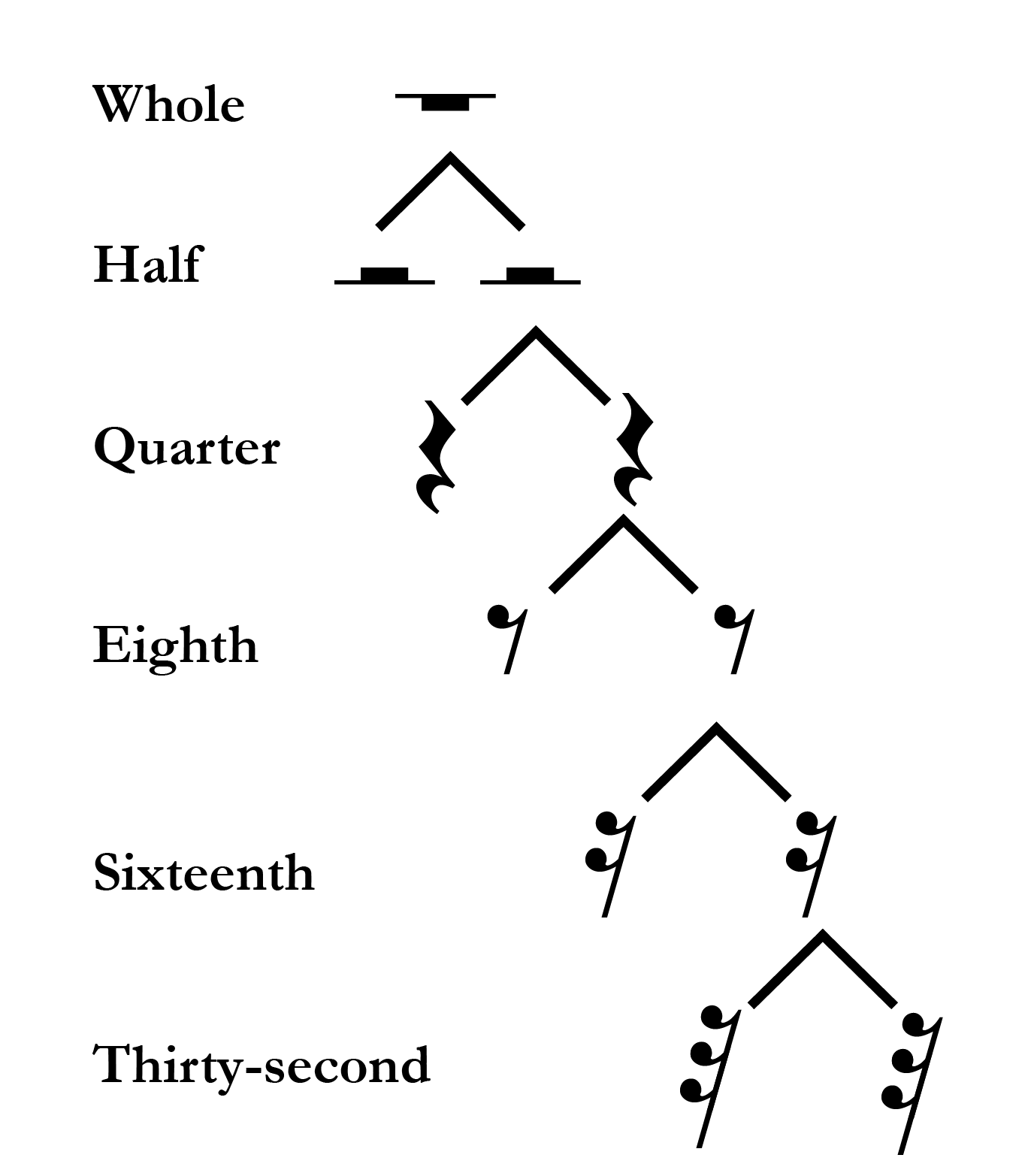Integrated Music Theory 2018-19
Discussion 4a - Simple Meters
Class Discussion
What is Meter?
-How we organize the beats in the music
-How we organize time in music
-It is a repeatble pattern
-A pattern of emphasis
-Helps us write music down
Hierarchy of meter
-Meter is split into beats, split into divisions, split into subdivisions
What characteristic do all simple meters share?
-They divide the beat in two equal parts
Describe top and bottom numbers of time signatures.
-The top number is the number of beats in a measure; the bottom number shows which rhythmic value gets the beat
Discuss beaming.
-I can see where each beat starts and the divisions and subdivisions
-Beats are beamed together
What does duple, triple, quadruple, etc. describe?
-Duple: two beats, Triple: three beats, Quadruple: four beats, Quintuple: five beats etc.
Further Reading
From Open Music Theory
Rhythm refers to the combination of long and short durations in time. Durations are notated with either unfilled or filled noteheads. Unfilled noteheads can appear with or without a stem; filled noteheads always appear with a stem. Flags can be added to the stems of filled noteheads; each flag shortens the duration by half.

Rests
Rests represent silence in musical notation. For each durational symbol there exists a corresponding rest.

Dots and ties
Dots and ties allow for basic durations to be lengthened. A dot occurs after a pitch or a rest, and it increases its duration by half. For example, if a quarter note is equivalent in duration to two eighth notes, a dotted quarter note would be equivalent to three eighth notes. Generally, undotted notes divide into two notes; dotted notes divide into three. Thus, undotted notes are typically used to represent the beat level in simple meter, while dotted notes are used to represent the beat in compound meter.
Multiple dots can be added to a duration. Subsequent dots add half the duration of the previous dot. For example, a quarter note with two dots would be equivalent in duration to a quarter, eighth, and sixteenth note.
A tie lengthens a duration by connecting two adjacent identical pitches. Ties are used to either sustain a pitch beyond the length of a single measure, or to make a particular rhythmic grouping in a measure more clear.
In the example below, the duration of the first pitch is longer than a single measure, so it is represented by tying the dotted half note, which lasts the full measure, to the first beat of the subsequent measure.
Meters
Meter involves the way multiple pulse layers work together to organize music in time. Standard meters in Western music can be classified into simple meters and compound meters, as well as duple, triple, and quadruple meters.
Duple, triple, and quadruple classifications result from the relationship between the counting pulse and the pulses that are slower than the counting pulse. In other words, it is a question of grouping: how many beats occur in each bar. If counting-pulse beats group into twos, we have duple meter; groups of three, triple meter; groups of four, quadruple meter. Conducting patterns are determined based on these classifications.
Simple and compound classifications result from the relationship between the counting pulse and the pulses that are faster than the counting pulse. In other words, it is a question of division: does each beat divide into two equal parts, or three equal parts. Meters that divide the beat into two equal parts are simple meters.
There are three types of standard simple meters in Western music:
- simple duple (beats group into two, divide into two)
- simple triple (beats group into three, divide into two)
- simple quadruple (beats group into four, divide into two)
In a time signature, the top number (and the top number only!) describes the type of meter. Following are the top numbers that always correspond to each type of meter:
- simple duple: 2
- simple triple: 3
- simple quadruple: 4
Notating meter
In simple meters, the bottom number of the time signature corresponds to the type of note corresponding to a single beat. If a simple meter is notated such that each quarter note corresponds to a beat, the bottom number of the time signature is 4. If a simple meter is notated such that each half note corresponds to a beat, the bottom number of the time signature is 2. If a simple meter is notated such that each eighth note corresponds to a beat, the bottom number of the time signature is 8. And so on.
Beaming
It’s important to remember that notation is intended to be read by performers. You should always strive to make your notation as easy to interpret as possible. Part of this includes grouping the rhythms such that they convey the beat unit and the beat division. Beams are used to group any notes at the beat division level or shorter that fall within the same beat.
In this example, the eighth notes are not grouped with beams, making it difficult to interpret the triple meter.
If we re-notate the above example so that the notes that fall within the same beat are grouped together with a beam, it makes the music much easier to read.
Borrowed divisions
Typically, a meter is defined by the presence of a consistent beat division: division by two in simple meter, and by three in compound meter. Occasionally, composers will use a triple division of the beat in a simple meter, or a duple division of the beat in a compound meter.
Triplets are borrowed from compound meter, and may occur at both the beat division and subdivision levels, as seen below.
Likewise, duplets can be imported from simple meter into a compound meter.
Hearing meter
For a more detailed explanation of meter with an emphasis on hearing and recognizing standard meters, see the following two videos:
Meter - counting pulse from Kris Shaffer on Vimeo.
Meter - grouping and division from Kris Shaffer on Vimeo.
Following are the musical examples referenced in the above videos:
"Come Out Clean," Jump Little Children
"With or Without You," U2
"The Tourist," Radiohead
Examples
Simple duple meter
Symphony No. 5, Movement IV., Ludwig van Beethoven
"Idioteque," Radiohead
Sonata No. 1 in F Minor, Op. 2, No. 1, Movement I., Ludwig van Beethoven
Simple triple meter
String Quartet No. 15 in D Minor, K. 421, Movement III., Wolfgang A. Mozart
Symphony No. 90 in C Major, Hob: I:90, Movement III., Joseph Haydn
Simple quadruple meter
"With or Without You," U2
"Come Out Clean," Jump Little Children
"Shh," Imogen Heap





